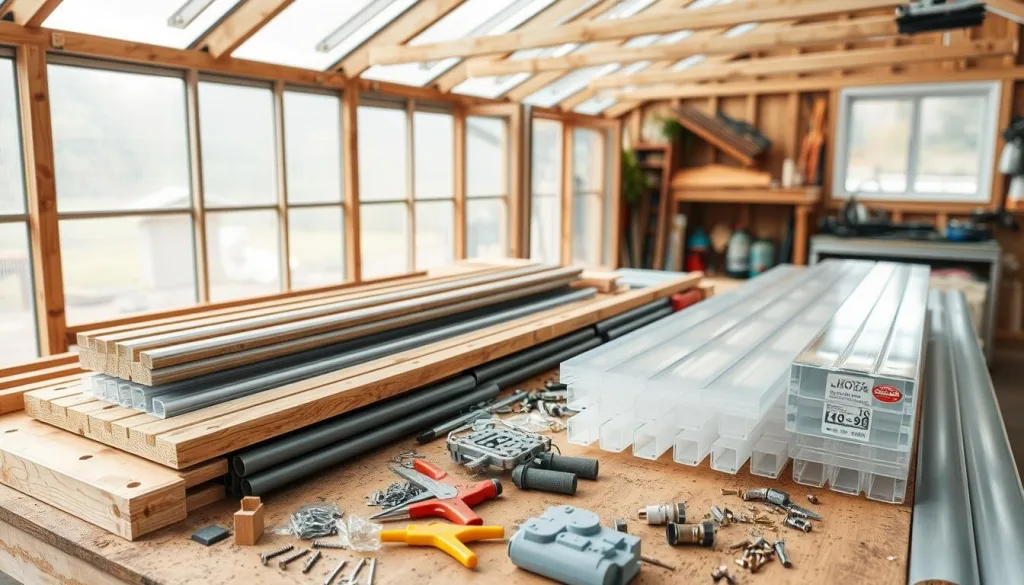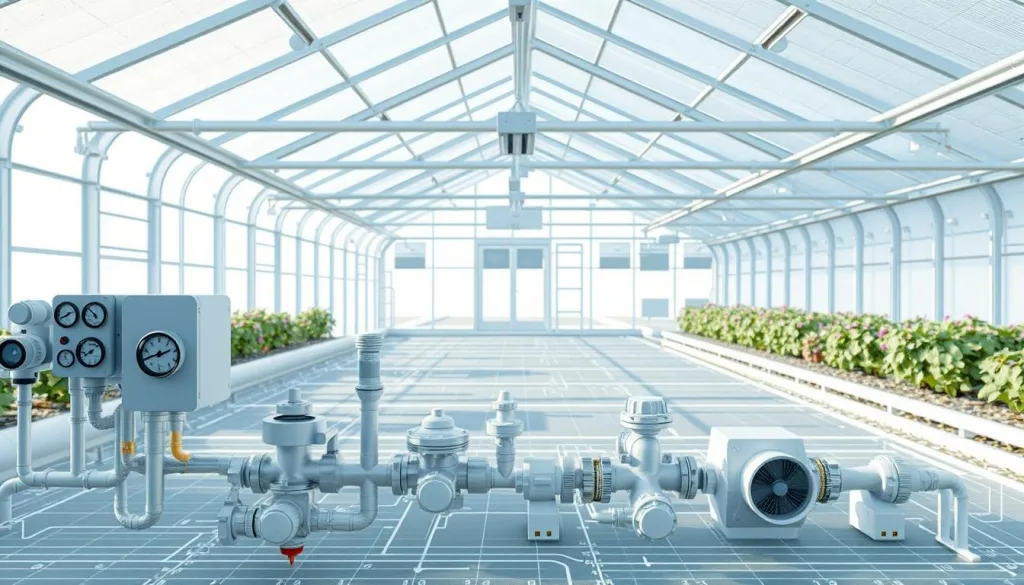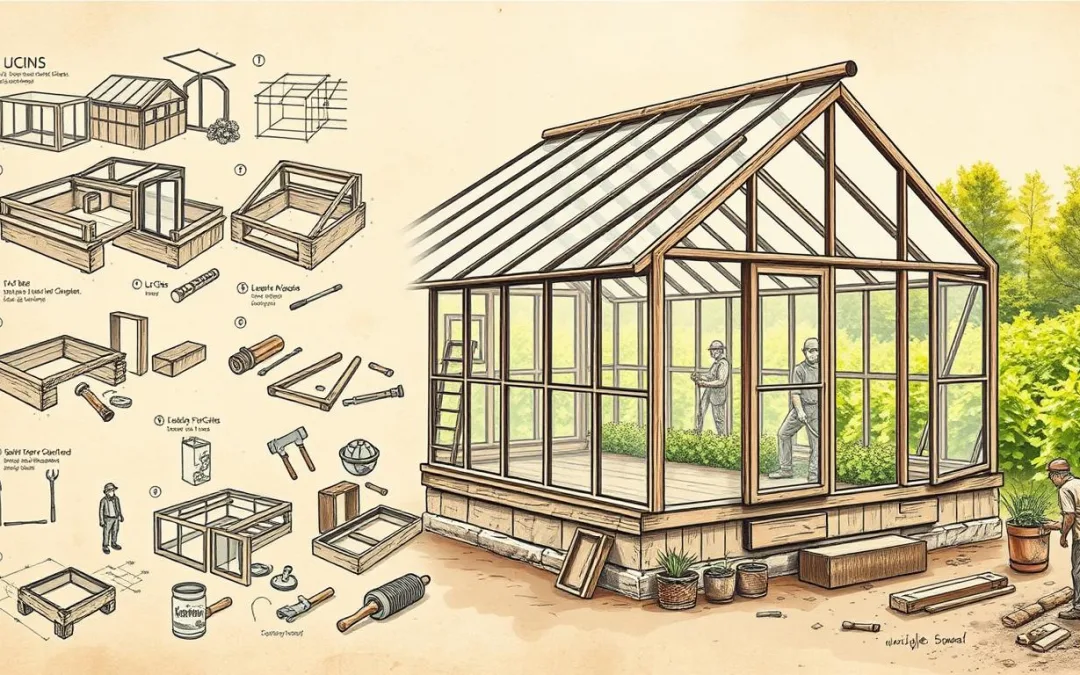Growing your own food has become more than just a hobby. It’s a sustainable lifestyle choice. Building a greenhouse can change how you produce food. The process is simpler than many think.
A homestead greenhouse guide is more than just building. It’s about creating a system for food all year. With the right design, you can grow veggies, herbs, and fruits even in winter. Building your own greenhouse lets you control your food supply.
Greenhouses offer many benefits. They boost food yield, protect plants from pests, and keep temperatures stable. Knowing the design principles can turn your homestead into a food powerhouse.
Key Takeaways
- Greenhouses extend growing seasons dramatically
- Proper location determines greenhouse success
- Material selection impacts long-term durability
- Pest protection increases plant survival rates
- Temperature control is critical for plant health
Understanding the Basics of Homestead Greenhouses
Greenhouse construction tips open a world of possibilities for gardeners and homesteaders. They create protected spaces that let us grow food all year. This extends our growing seasons and boosts our harvests.
When building a home greenhouse, knowing about different structures is key. Let’s explore the basics of creating your own greenhouse haven.
Greenhouse Structure Types
- Gable Greenhouses: Traditional peaked roof design
- Lean-To Structures: Attached to existing buildings
- Geodesic Domes: Rounded shapes maximizing solar gain
- Hoop Houses: Affordable, flexible growing spaces
Key Greenhouse Components
| Component | Function |
|---|---|
| Framing | Structural support (wood, aluminum, PVC) |
| Glazing | Light transmission (polycarbonate, glass) |
| Ventilation | Temperature and humidity control |
| Irrigation | Consistent plant watering system |
Benefits of Homestead Greenhouses
Building a greenhouse is a smart move for gardeners. These spaces offer many benefits. They can:
- Extend growing seasons by 4-6 months
- Increase plant growth rates by 20-30%
- Protect crops from harsh weather
- Create perfect growing conditions all year
To build a successful greenhouse, plan carefully. Understand your needs and choose the right design for your homestead.
Tips for Building a Greenhouse on Your Homestead
Building a greenhouse on your homestead needs careful planning. Start by understanding what you need for a successful project. DIY fans can make a great greenhouse with the right design and materials.
Here are the best ways to build a strong and efficient greenhouse:
- Select a level site with maximum sun exposure
- Choose durable materials that withstand local weather conditions
- Plan for proper ventilation and temperature control
- Invest in quality greenhouse plastic paneling
- Create a solid foundation using concrete blocks or wood framing
For a 10×16 foot greenhouse, budget about $745.96. You’ll need:
- 21 sheets of 12′ greenhouse plastic paneling
- 4 sheets of 8′ greenhouse plastic paneling
- 9 packages of horizontal wood stripping
- 22 lumber boards (mix of 2×4 lengths)
- 4 concrete blocks for foundation stability
Pro tip: Always plan for extra time and budget for surprises. Experienced homesteaders suggest budgeting for cost overruns and setting aside about a week for assembly.
When building your greenhouse, think about wind resistance, temperature control, and climate adaptability. A well-built greenhouse can let you grow plants all year round.
Choosing the Perfect Location and Orientation
Finding the right spot for your greenhouse is key to a thriving garden. Green thumb tips start with how location affects your plants’ health and growth.
When looking at greenhouse materials and design tips, remember these important factors:
- Solar exposure is vital for plant growth
- Wind protection keeps the structure strong
- Good drainage stops water problems
- Being close to other buildings affects sunlight and access
Solar Exposure Considerations
The best spot for your greenhouse is usually on the south or southeast side. This spot gets the most sunlight, which is important in winter when plants need it most.
| Location Ranking | Solar Efficiency |
|---|---|
| 1st Choice | South/Southeast Side |
| 2nd Choice | East Side |
| 3rd Choice | Southwest/West Side |
| Least Optimal | North Side |
Wind Protection and Drainage Requirements
Strategic placement helps shield your greenhouse from strong winds. Stay away from slopes where cold air settles, raising frost risks. Use natural windbreaks like strong fences or smart landscaping.
Distance from Existing Structures
Keep your greenhouse far enough from your house to avoid shading but close enough to reach easily. The best spot allows for growth and ensures sunlight all day.
Pro tip: Position your greenhouse lengthwise from north to south to maximize light exposure and reduce shading.
Essential Materials and Design Features

Choosing the right materials is key for a successful greenhouse. The design of your greenhouse affects its performance and how long it lasts. Building a greenhouse requires careful thought about many parts to create the best growing space.
Important materials for building a DIY greenhouse include:
- Framing options:
- Wood (can last up to 50 years in dry climates)
- Galvanized steel
- Aluminum
- Glazing materials:
- Double-pane glass (best insulation)
- Polycarbonate panels (10+ years lifespan)
- Polyethylene sheets
Temperature regulation is a vital part of greenhouse design. Temperature-sensitive vents open and close automatically, without needing electricity. Most plants prefer temperatures between 75-90 degrees Fahrenheit.
Design features to improve greenhouse performance include:
- Solar exposure (minimum 6 hours of sunlight daily)
- Proper ventilation systems
- Thermal mass elements like dark-colored water tanks
- Slatted tables for water drainage
When planning your DIY greenhouse, think about its orientation. In North America, facing south or southeast gets the most sunlight. Start with a size of 12 × 30 feet, aiming for a length-to-width ratio of 3:1.
Solar-Powered Systems and Energy Efficiency
To make your homestead greenhouse energy-efficient, use solar power wisely. This renewable energy can turn your green thumb greenhouse building tips into a place where plants thrive and energy costs drop.
Using solar power in your greenhouse has many benefits. The U.S. government offers a 30% tax credit for solar systems. This makes solar power a smart choice for those who love building greenhouses.
Solar Panel Integration Strategies
When planning your solar-powered greenhouse, keep these points in mind:
- Panel efficiency depends on where you are and how much sun you get
- You can generate about 54 kWh of energy per month per panel
- Decide between systems that connect to the grid or stand alone
Passive Solar Design Elements
Passive solar design is more than just solar panels. Smart structural choices can help control the greenhouse’s temperature naturally:
- Black rocks absorb heat
- Design the roof to catch more sunlight
- Use materials that keep heat in
Ventilation and Temperature Control
Keeping the right temperature is key for a successful greenhouse. Solar power can help with:
- Automated solar fans for air flow
- Smart systems for ventilation
- IoT for monitoring temperature
| Solar System Type | Energy Output | Cost Efficiency |
|---|---|---|
| Grid-Tied System | Net Metering Possible | High |
| Off-Grid System | Full Energy Freedom | Medium |
| Hybrid System | Flexible Energy Use | Very High |
By smartly using solar technology, you can build an energy-saving greenhouse. It will help plants grow all year and lessen harm to the environment.
Building a Climate Control System

Creating a good climate control system is key for a successful home greenhouse. It ensures your plants grow well all year. You need to plan carefully for temperature, humidity, and air flow.
Keeping the right temperature is essential. Most plants do best in temperatures between 62°F and 76°F. Nighttime should stay above 45°F. To manage this, use several methods:
- Hybrid solar-electric ventilation systems
- Thermal mass water storage
- Insulation techniques
- Strategic heating methods
Our advice for building a home greenhouse includes a special ventilation system. It uses solar power to bring in cool air. You can also plug it in for constant use when the sun isn’t strong enough.
| Climate Control Method | Effectiveness | Energy Requirement |
|---|---|---|
| Solar Intake Fan | High | Low |
| Water Thermal Mass | Medium-High | None |
| Propane Heaters | High | Medium |
Pro tip: Adding passive solar design can save a lot on energy. Use 5-10 gallon water containers to keep heat in at night. This helps control the temperature naturally.
Managing humidity is also important. Keep it between 70-80% for best plant growth. Use automated sensors and controls to keep the environment stable with little effort.
Sustainable Features and Environmental Impact
Building an eco-friendly greenhouse needs careful planning and creative designs. Today, making greenhouses focuses on being green. It uses materials and designs that are good for the planet and help plants grow well.
Managing a green greenhouse means using smart strategies. These strategies help grow food while protecting the environment. Homesteaders can make spaces that are great for growing food and caring for nature.
Water Conservation Methods
Using water wisely is key for a green greenhouse. Here are some smart ways to save water:
- Use drip irrigation systems to cut water use by 30-70%
- Collect rainwater for your greenhouse
- Set up moisture sensors to water plants just right
- Recycle and clean water in a closed-loop system
Eco-friendly Material Choices
Choosing the right materials for your greenhouse is important. Look for materials that are good for the planet. Use materials that are made from renewable or recycled sources.
| Material | Sustainability Rating | Key Benefits |
|---|---|---|
| Reclaimed Wood | High | Less carbon, helps forests grow back |
| Recycled Aluminum | Medium-High | Can be recycled forever, light |
| Bamboo | Very High | Grows fast, absorbs lots of CO2 |
| Recycled Steel | High | Strong, can be recycled many times |
By using these green features, homesteaders can make greenhouses that grow food well and care for the planet. Choosing the right materials, managing water, and saving energy can turn a simple greenhouse into a green model.
Year-Round Growing Strategies
To make a homestead greenhouse work all year, you need a good plan. Knowing how to grow crops in different seasons is key. This ensures you always have food.
Creating a homestead greenhouse guide is vital. It helps you tackle seasonal challenges. Each crop has its own needs, so planning is essential.
- Winter Strategies: Focus on cold-hardy vegetables like kale, spinach, and root crops
- Utilize vertical gardening techniques to maximize limited space
- Implement supplemental heating for temperature-sensitive plants
- Use row covers and microclimate zones within the greenhouse
Greenhouse gardening needs you to know your local climate. Adapting to it is important. In areas with less daylight, you’ll need special lighting and heating.
Keeping the right temperature is critical. Use good thermostats and ventilation. Container gardening lets you move plants, protecting them from harsh weather.
Off-Grid vs. On-Grid Greenhouse Options
When planning your DIY greenhouse, knowing your energy options is key. Growing Spaces started with off-grid greenhouses, inspired by Buckminster Fuller’s 1976 design. Now, you can choose from many power setups, each with its own benefits for building your greenhouse.
The hybrid greenhouse mixes off-grid and on-grid systems for more flexibility. Solar parts can power irrigation, fans, and even water features. A new battery system helps keep things running on cloudy days or at night.
On-grid systems have stronger fans and work 24/7. Off-grid options give you full energy freedom. You can pick what works best for you, with benefits in under a year. The goal is to find a balance between being green, practical, and meeting your homestead needs.
Growing Spaces now serves all 50 states and 14 countries. This shows how appealing and versatile these greenhouses are. Whether you go off-grid, on-grid, or hybrid, the aim is the same: a sustainable space for growing food.
FAQ
What are the main types of greenhouse structures suitable for a homestead?
How do I choose the best location for my greenhouse?
What are the most important materials for greenhouse construction?
How can I make my greenhouse energy-efficient?
What are the best strategies for year-round growing?
Should I choose an off-grid or on-grid greenhouse system?
What are the most important sustainable features for a greenhouse?
How do I manage climate control in my greenhouse?
Source Links
- A Beginner’s Guide to Using a Hobby Greenhouse – https://homesteadandchill.com/beginners-guide-using-hobby-greenhouse/?srsltid=AfmBOop9HN6OQ5ldT8YfOMr8GKL34T_jJ4GmqbotCeKK5Mv2tiZQFm_W
- How to Build a Concrete Block Greenhouse Foundation – https://homesteadandchill.com/concrete-block-greenhouse-foundation/?srsltid=AfmBOorVq4ayMNXj3FJ5tQQ6A8RFl5SRHLWDXoGdyNBb0ZFTRoUv_-PB
- How to Build a Greenhouse (free plans!) – Boots & Hooves Homestead – https://bootsandhooveshomestead.com/how-to-build-a-greenhouse/
- How to Build a Greenhouse for Your Homestead – Earthineer – https://earthineer.com/food/gardening/how-to-build-a-greenhouse-for-your-homestead/
- How To Build A Greenhouse — The Elliott Homestead – https://www.theelliotthomestead.com/blog/2014/07/how-to-build-a-greenhouse
- A Beginner’s Guide to Using a Hobby Greenhouse – https://homesteadandchill.com/beginners-guide-using-hobby-greenhouse/?srsltid=AfmBOor1GXfpCeNVI8gVPwOxyHUXxw1FK_1AIcNF0wRhO-Uz04xkuHNR
- The Homestead Greenhouse – Backwoods Home Magazine – https://www.backwoodshome.com/the-homestead-greenhouse/
- Greenhouse Location Guide: Learn Where To Put Your Greenhouse – https://www.gardeningknowhow.com/special/greenhouses/where-to-put-greenhouse.htm
- Build the Perfect Greenhouse Kit for Your Climate – https://growingspaces.com/climate-options/
- Attached Greenhouse: Pros and Cons – https://practicalselfreliance.com/attached-greenhouse/
- How To Design The Perfect Greenhouse – https://www.azurefarmlife.com/farm-blog/the-perfect-greenhouse
- 9 Things to Consider When Building Your Own Greenhouse – https://www.chelseagreen.com/2023/considerations-building-greenhouse/?srsltid=AfmBOoqfrJG6QLMMulMxPkjOu4v0YC5Cn0OdXA-1kl8S4JPNquz9ZMjN
- The Complete Guide to Solar-Powered Greenhouses – https://blog.ecoflow.com/us/solar-powered-greenhouses-guide/
- How to heat a greenhouse with solar panels – https://green-living.na.panasonic.com/articles/how-to-heat-a-greenhouse-with-solar-panels
- How to Heat a Greenhouse Without Electricity – https://homesteadingfamily.com/how-to-heat-a-greenhouse-without-electricity/
- How to Keep a Greenhouse Warm – https://growingspaces.com/how-to-keep-a-greenhouse-warm/
- DIY Greenhouses: A Comprehensive Guide to Building Your Own Greenhouse – The Homestead Survival – https://thehomesteadsurvival.com/diy-greenhouses-a-comprehensive-guide-to-building-your-own-greenhouse/
- How to reduce the environmental impact of greenhouses – https://www.lettusgrow.com/blog/reduce-greenhouse-environmental-impact
- 6 Steps to Design A Sustainable Greenhouse | AgriTechTomorrow – https://www.agritechtomorrow.com/article/2024/11/6-steps-to-design-a-sustainable-greenhouse/16083
- 6-Step Guide to Designing and Creating a Sustainable Greenhouse | GBB° – https://www.greenbusinessbenchmark.com/archive/6-step-greenhouse-guide
- How to Grow Greens Year Round – https://homesteadingfamily.com/how-to-grow-greens-year-round/
- A Homesteader’s Guide to Greenhouse Gardening – https://survivaljack.com/2023/06/a-homesteaders-guide-to-greenhouse-gardening/
- What Plants to Grow in Year-Round Greenhouse | Prospiant – https://www.prospiant.com/what-to-grow-in-a-year-round-greenhouse/
- Plug In or Power Up? Unveiling the Secrets of On-Grid and Off-Grid Greenhouse Options – https://growingspaces.com/on-v-off-grid-greenhouse/
- How a Greenhouse Can Pay Off for Your Homestead – https://rimol.com/posts/how-a-greenhouse-can-pay-off-for-your-homestead/


